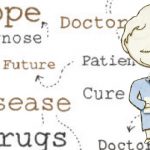Social History 1st
Humans & dogs are social animals, so social history should come first.
After a few minutes—and a few doggie treats that calmed down little Lexi, the veterinarian—let’s call her Dr. N—entered the room. She said a few words to say hello and got straight to work looking at the chart in the computer and the questionnaire. I was struck by the quick pace of everything before she turned around to me and began asking me the customary questions. To tell you the truth, I was skeptical—would she go over the same things that I had just answered on the questionnaire?
No, Dr. N was wiser than that. She started with, “How’s Stella doing?” Stella is our older pup, who, at that time, was around 6 years old. At first I thought it was a rapport-building question. Certainly the patient experience consultants who periodically come around to our clinics encourage us to ask questions like that to improve the clinic’s patient satisfaction numbers.
But she didn’t take “fine” as an answer. She dug in deeply: Does Stella have a limp? How does Stella play with Lexi? And so forth. It wasn’t just a pleasantry for patient satisfaction. Dr. N was very subtly taking a history while putting me at ease. Then she asked us about our kids and how Lexi interacts with the kids. Here, Dr. N wasn’t getting a social history for the sake of billing but was trying to put together a richer, more detailed picture of whether some external force had prompted Lexi’s limp.
That was something new to me. In medical school and throughout postgraduate training, the typical structure of a clinic visit starts with a golden minute of small talk, followed by a direct inquiry into the chief complaint. Social history and other elements are expected to come later—but Dr. N flipped this entirely. She segued the golden minute into the social history and used that as the basis for understanding the chief complaint.
While I can’t imagine doing this on a first clinical consultation visit, I can surely imagine doing it on routine follow-ups. It makes complete sense to me to start off with how chronic diseases that involve lifestyles and social relationships impact patients’ social lives and how their social lives impact their disease activity.
The History
Only after getting the social history did Dr. N solicit the chief concern and inquire about the review of systems. This, I was pleasantly surprised, was pretty much the same as an encounter in the rheumatology clinic. She asked the five elements of pain (i.e., location, severity, duration, associated symptoms and modifying factors) and seemed to go from head to toe, probing for any further context. Yet there was an important difference between how she performed the review of systems and how I would in my clinic.

